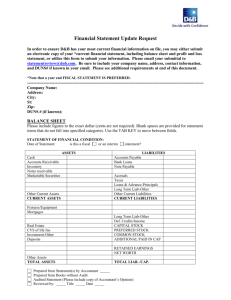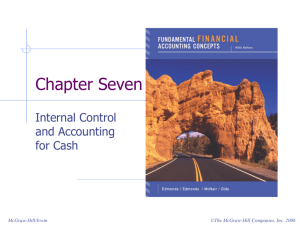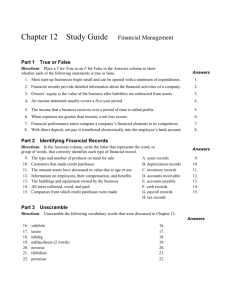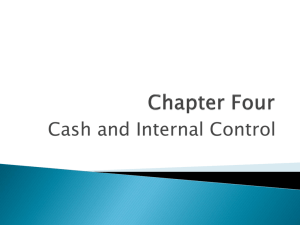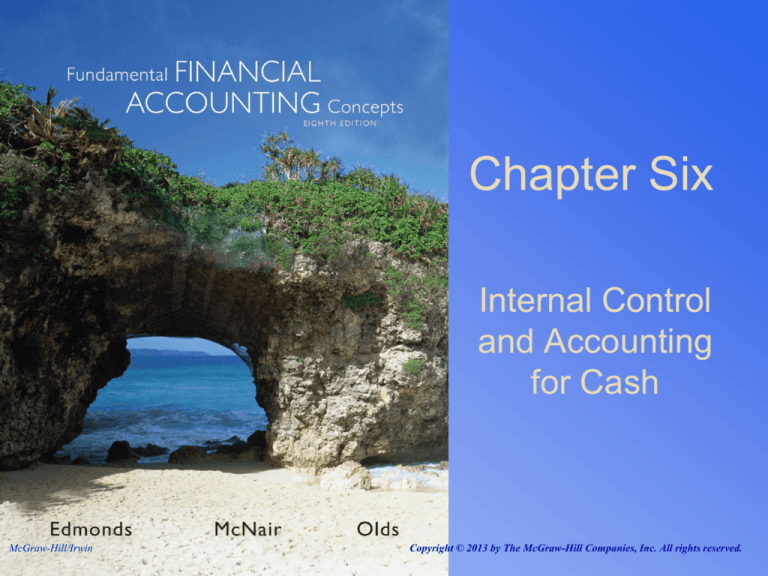
Chapter Six
Internal Control
and Accounting
for Cash
McGraw-Hill/Irwin
McGraw-Hill/Irwin
Copyright © 2013 by The McGraw-Hill Companies, Inc. All rights reserved.
What Is Internal Control?
The policies and procedures by
which management protects the
assets and assures the accuracy and
reliability of the accounting records.
Goals of an internal control
system:
• Resources of the
business are
safeguarded
• Policies of management
are followed
• Designed to prevent
errors and fraud
Key Features of Internal Control
1.
2.
3.
4.
5.
6.
7.
8.
9.
Separation of Duties
Quality of Employees
Bonded Employees
Required Absences
Procedures Manual
Authority and Responsibility
Prenumbered Documents
Physical Control
Performance Evaluations
Separation of duties
• Whenever possible, the
functions of
authorization, recording
and custody should be
exercised by separate
individuals.
• This minimizes the
likelihood of errors and
embezzlement.
Quality of employees
Hire and keep employees
that are:
• Competent
• Honest
• Trained to do a variety of
tasks.
Bonded Employees
A fidelity bond provides insurance that protects a
company from loss caused by employee
dishonesty. To become bonded, an employee’s
background is investigated.
Required Absences
An employee may be able to cover up
fraudulent activities if they are always present
at work. All employees should be required to
take regular vacations and their duties should
be rotated periodically.
Procedures Manual
Accounting and other important procedures should be
written in a procedures manual. Periodically,
management should conduct an investigation to see
that required procedures are actually being followed.
Prenumbered Documents.
Prenumbered forms are used for all important
documents such as checks, purchase orders, receiving
reports, and invoices. The use of prenumbered forms
helps keep track of all forms issued during a particular
period.
Physical Control
All companies should maintain adequate physical
control over valuable assets that may be
misappropriated. For example, inventory should be
properly stored in a secure location. Serial numbers
should be placed on all valuable assets to assist in
a physical count of these assets.
Performance Evaluation
•Internal controls should include independent verification
of employee performance.
•A physical inventory should be taken at least annually.
An independent reconciliation between the general
ledger balance and inventory should be compared to the
inventory count.
•Auditors should evaluate the effectiveness of the control
system.
Accounting for Cash
Cash receipts should
be recorded
immediately upon
receipt and deposited
intact daily.
Up to date signature
card should be
maintained.
A monthly bank
reconciliation should
be prepared by an
independent party.
Internal
Controls for
Cash
A deposit ticket
should be used for
all deposits.
Cash disbursements
should be made by
prenumbered check.
Reconciling the Bank Statement
The bank reconciliation reports on the differences
between the balance on the bank statement and the
balance in the general ledger cash account. The
reconciliation results in the true cash balance that
will appear on the balance sheet.
Adjustment to the Bank Balance
Unadjusted bank balance
+ Deposits in transit
Deduct - Outstanding checks
Equals = True cash balance
Add
Adjustments to the Book Balance
Unadjusted book balance
Add + Accounts receivable collections
+
Deduct Deduct Equals =
Add
Interest earned
Bank service charges
Non-sufficient funds (NSF) check
True cash balance
Reconciling the Bank Statement
If an error is found on the bank statement, an
adjustment for it is made to the unadjusted
bank balance to determine the true cash
balance. An error made on our books requires
an adjusting journal entry to correct.
Bank Reconciliation
Matrix, Inc. is preparing the bank reconciliation for the month
of June.
1. The June 30th balance on the bank statement is
$4,892.56, and the Cash general ledger balance on this
date is $4,240.54.
2. There was a deposit in transit in the amount of $475.
Bank Reconciliation
Matrix, Inc.
Bank Reconciliation Statement
June 30, 2011
Unadjusted bank balance, June 30
Add: Deposits in transit
Bank error
Less: Outstanding checks
Check No. 1078 - June 28
372.33
Check No. 1080 - June 29
402.41
Check No. 1081 - June 30
66.89
True Cash balance, June 30
Unadjusted Book Balance, June 30
Add: Account collected by bank
Bookkeeping error
Interest earned on checking account
Less: Bank service charge
NSF Check
True Cash balance, June 30
$ 4,892.56
475.00
200.00
(841.63)
$ 4,725.93
$ 4,240.54
875.00
27.00
9.25
(12.75)
(413.11)
$ 4,725.93
Bank Reconciliation
Matrix, Inc. is preparing the bank reconciliation for the month
of June.
1. The June 30th balance on the bank statement is
$4,892.56, and the Cash general ledger balance on this
date is $4,240.54.
2. There was a deposit in transit in the amount of $475.
3. The bank erroneously deducted a $200 check drawn
on the books of Matters, Inc. from our account.
Bank Reconciliation
Matrix, Inc.
Bank Reconciliation Statement
June 30, 2011
Unadjusted bank balance, June 30
Add: Deposits in transit
Bank error
Less: Outstanding checks
Check No. 1078 - June 28
372.33
Check No. 1080 - June 29
402.41
Check No. 1081 - June 30
66.89
True Cash balance, June 30
Unadjusted Book Balance, June 30
Add: Account collected by bank
Bookkeeping error
Interest earned on checking account
Less: Bank service charge
NSF Check
True Cash balance, June 30
$ 4,892.56
475.00
200.00
(841.63)
$ 4,725.93
$ 4,240.54
875.00
27.00
9.25
(12.75)
(413.11)
$ 4,725.93
Bank Reconciliation
Matrix, Inc. is preparing the bank reconciliation for the month
of June.
1. The June 30th balance on the bank statement is $4,892.56,
and the Cash general ledger balance on this date is
$4,240.54.
2. There was a deposit in transit in the amount of $475.
3. The bank erroneously deducted a $200 check drawn on the
books of Matters, Inc. from our account.
4. At June 30th there were three checks outstanding.
Check 1078 dated 6/28, for $372.33; Check 1080 dated
6/29, for $402.41; and Check 1081 dated 6/30, for
$66.89.
Bank Reconciliation
Matrix, Inc.
Bank Reconciliation Statement
June 30, 2011
Unadjusted bank balance, June 30
Add: Deposits in transit
Bank error
Less: Outstanding checks
Check No. 1078 - June 28
372.33
Check No. 1080 - June 29
402.41
Check No. 1081 - June 30
66.89
True Cash balance, June 30
Unadjusted Book Balance, June 30
Add: Account collected by bank
Bookkeeping error
Interest earned on checking account
Less: Bank service charge
NSF Check
True Cash balance, June 30
$ 4,892.56
475.00
200.00
(841.63)
$ 4,725.93
$ 4,240.54
875.00
27.00
9.25
(12.75)
(413.11)
$ 4,725.93
Bank Reconciliation
5. During the month of June the bank collected an
account receivable for us in the amount of $875.
Bank Reconciliation
Matrix, Inc.
Bank Reconciliation Statement
June 30, 2011
Unadjusted bank balance, June 30
Add: Deposits in transit
Bank error
Less: Outstanding checks
Check No. 1078 - June 28
372.33
Check No. 1080 - June 29
402.41
Check No. 1081 - June 30
66.89
True Cash balance, June 30
Unadjusted Book Balance, June 30
Add: Account collected by bank
Bookkeeping error
Interest earned on checking account
Less: Bank service charge
NSF Check
True Cash balance, June 30
$ 4,892.56
475.00
200.00
(841.63)
$ 4,725.93
$ 4,240.54
875.00
27.00
9.25
(12.75)
(413.11)
$ 4,725.93
Bank Reconciliation
5. During the month of June the bank collected an account
receivable for us in the amount of $875.
6. A check actually written for $146.88 for supplies was
erroneously recorded in our records by the
bookkeeper as $173.88.
7. Matrix earned interest of $9.25 on its checking
account.
Bank Reconciliation
Matrix, Inc.
Bank Reconciliation Statement
June 30, 2011
Unadjusted bank balance, June 30
Add: Deposits in transit
Bank error
Less: Outstanding checks
Check No. 1078 - June 28
372.33
Check No. 1080 - June 29
402.41
Check No. 1081 - June 30
66.89
True Cash balance, June 30
Unadjusted Book Balance, June 30
Add: Account collected by bank
Bookkeeping error
Interest earned on checking account
Less: Bank service charge
NSF Check
True Cash balance, June 30
$ 4,892.56
475.00
200.00
(841.63)
$ 4,725.93
$ 4,240.54
875.00
27.00
9.25
(12.75)
(413.11)
$ 4,725.93
Bank Reconciliation
5. During the month of June the bank collected an account
receivable for us in the amount of $875.
6. A check actually written for $146.88 for supplies was
erroneously recorded in our records by the bookkeeper
as $173.88.
7. Matrix earned interest of $9.25 on its checking account.
8. The bank sent a debit memo for a service charge of
$12.75 for June and a check we deposited was
deemed NSF in the amount of $413.11.
Bank Reconciliation
Matrix, Inc.
Bank Reconciliation Statement
June 30, 2011
Unadjusted Bank Balance, June 30
Add: Deposits in transit
Bank error
Less: Outstanding checks
Check No. 1078 - June 28
372.33
Check No. 1080 - June 29
402.41
Check No. 1081 - June 30
66.89
True Cash balance, June 30
Unadjusted Book Balance, June 30
Add: Account collected by bank
Bookkeeping error
Interest earned on checking account
Less: Bank service charge
NSF Check
True Cash balance, June 30
$ 4,892.56
475.00
200.00
(841.63)
$ 4,725.93
$ 4,240.54
875.00
27.00
9.25
(12.75)
(413.11)
$ 4,725.93
Adjusting the Books
Every reconciling item that appears on the unadjusted
book balance section requires a journal entry to adjust
the general ledger cash balance to the true cash
balance.
Account Title
Cash
Accounts receivable
Supplies expense
Interest revenue
Bank service charge expense
Accounts receivable
Cash
Debit
911.25
Credit
875.00
27.00
9.25
12.75
413.11
425.86
Cash Short and Over
When using a cash register, employees
sometimes make mistakes in collecting cash or
making change for customers. If the cash register
does not reconcile by a small amount at the end
of the day, we use an account called cash short
and over to force a balance.
Assume a cash
register was to have
a balance of $500
(based on receipts),
but contained only
$499 at the end of
the day.
Account Title
Cash
Cash short and over
Sales
Debit
499.00
1.00
Credit
500.00
Using Petty Cash Funds
A petty cash fund is used to make small
expenditures that cannot wait for the formal checkwriting process. The fund is operated on an imprest
basis. This means that when the fund gets low on
cash it is replenished. The petty cashier is always
responsible for the cash in the fund. This is an
excellent internal control.
Using Petty Cash Funds
Establishing a $500 petty cash fund.
Account Title
Petty cash
Cash
Debit
500.00
Credit
500.00
Petty cashier takes
the check to the
bank and gets $500
cash for the fund.
Treasurer prepares
a $500 check
payable to the petty
cashier.
Using Petty Cash Funds
During the month the petty cashier paid out $217 for
FedEx deliveries, $34.50 for late-working employee
meals, $27 for cab fare to the airport for a
salesperson, and $187.60 for office postage stamps.
The petty cashier asked for and received a receipt
for each disbursement made this month. The fund is
getting low on cash so the petty cashier requests
that the fund be replenished.
Using Petty Cash Funds
Here is an analysis of the impact of the replenishment.
Assets
= Liab.
(466.10) = NA
+ Equity
Rev.
–
Exp.
+
NA
–
466.10 =
(466.10)
= Net Inc.
(466.10)
Cash Flow
(466.10) OA
The journal entry to record the reimbursement would be:
Account Title
Delivery Expense
Employee Meal Expense
Taxi Expense
Postage Expense
Cash
Debit
217.00
34.50
27.00
187.60
Credit
466.10
Using Petty Cash Funds
Petty cashier takes
the check to the
bank and gets
$466.10 cash for
the fund.
Treasurer prepares
a $466.10 check
payable to the petty
cashier.
The fund is now returned to its $500 balance.
Cash Short and Over
For Petty Cash:
1.Add up all receipts (total $85)
2.Subtract total from opening balance of
cash ($200 – 85) = $115
3.Count cash in box: If it is
a. Less than $115, then you are short
b. More than $115, then you are over
Current Versus Noncurrent
Current assets are expected to be converted to cash or
consumed within one year or an operating cycle,
whichever is longer. Current assets include:
•Cash
•Marketable Securities
•Accounts Receivable
•Short-Term Notes Receivable
•Interest Receivable
•Inventory
•Supplies
•Prepaids
Current Versus Noncurrent
Current liabilities are due within one year or an operating cycle, whichever
is longer. Current liabilities include:
•Accounts Payable
•Short-Term Notes Payable
•Wages Payable
•Taxes Payable
•Interest Payable
Winona Co. Balance Sheet at Dec. 31
Assets
Current Assets:
Cash
Marketable Securities
Accounts Receivable
Office Supplies
Inventory
Prepaid Insurance
Total Current Assets
Property, Plant and Equip:
Land
Building, net
Equipment, net
Total Prop.,Plant, Equip.
Total Assets
Liabilities and Owners’ Equity
Current Liabilities:
$ 100
Accounts Payable
300
Notes Payable
600
Unearned Revenue
40
Total Cur. Liab.
2,900 Long-Term Liabilities:
60
Mortgage Payable
$ 4,000
Notes Payable
Tot.. Lg-Term Liab.
Total Liabilities
$ 200
Equity
3,000 Contributed Capital
2,800 Retained Earnings
$ 6,000
Total Owners’ Equity
$10,000 Tot. Liab. and Own. Eq.
$
800
700
300
$ 1,800
$ 2,800
2,000
$ 4,800
$ 6,000
$ 1,000
3,000
$ 4,000
$10,000
Operating cycle
• the average time it takes a
business to convert cash
into inventory, inventory
into AR, and AR back into
cash.
Cash
Inventory
Operating cycle
• the average time it takes a
business to convert cash
into inventory, inventory
into AR, and AR back into
cash.
Cash
AR
Inventory
Operating cycle
• the average time it takes a
business to convert cash
into inventory, inventory
into AR, and AR back into
cash.
Cash
AR
Inventory
The Current Ratio
• Used to evaluate a company’s
liquidity (a company’s ability
to generate short term cash
flows)
Current Assets
Current Liabilities
Calculate the Current Ratio using the Balance Sheet
data on the following slide.
Winona Co. Balance Sheet at Dec. 31
Assets
Current Assets:
Cash
Marketable Securities
Accounts Receivable
Office Supplies
Inventory
Prepaid Insurance
Total Current Assets
Property, Plant and Equip:
Land
Building, net
Equipment, net
Total Prop.,Plant, Equip.
Total Assets
Liabilities and Owners’ Equity
Current Liabilities:
$ 100
Accounts Payable
300
Notes Payable
600
Unearned Revenue
40
Total Cur. Liab.
2,900 Long-Term Liabilities:
60
Mortgage Payable
$ 4,000
Notes Payable
Tot.. Lg-Term Liab.
Total Liabilities
$ 200
Equity
3,000 Contributed Capital
2,800 Retained Earnings
$ 6,000
Total Owners’ Equity
$10,000 Tot. Liab. and Own. Eq.
$
800
700
300
$ 1,800
$ 2,800
2,000
$ 4,800
$ 6,000
$ 1,000
3,000
$ 4,000
$10,000
Winona Co. Balance Sheet at Dec. 31
Assets
Current Assets:
Cash
Marketable Securities
Accounts Receivable
Office Supplies
Inventory
Prepaid Insurance
Total Current Assets
Current Ratio =
Liabilities and Owners’ Equity
Current Liabilities:
$ 100
Accounts Payable
$ 800
300
Notes Payable
700
600
Unearned Revenue
300
40
Total Cur. Liab.
$ 1,800
2,900
60
$ 4,000
Current Assets
Current Liabilities
=
$4,000
$1,800
You have $2.22 of current assets for each $1 of current liabilities.
Is that enough?
=
2.22 to 1
The Quick (Acid-Test) Ratio
• A STRICTER test of a
company’s liquidity.
• The numerator only includes
cash, short term receivables
and short-term investments
(never includes inventory,
supplies or prepaids).
Quick Assets
Current Liabilities
Dec.
31
Balance
Sheet
data
Assets
Liabilities and Owners’ Equity
Current Assets:
Cash
Marketable Securities
Accounts Receivable
Office Supplies
Inventory
Prepaid Insurance
Total Current Assets
Quick Ratio =
$
100
300
600
40
2,900
60
$ 4,000
Quick Assets
Current Liabilities
Current Liabilities:
Accounts Payable
Notes Payable
Unearned Revenue
Total Cur. Liab.
=
$1,000
=
$
800
700
300
$ 1,800
.56 to 1
$1,800
Winona has $0.56 of “quick” assets for each $1 of current liabilities.
Is that enough? “Rule of Thumb” is 1 to 1 (but varies by industry).
The Financial Analyst
How can a
financial
analyst know
that a company
really did
follow GAAP?
Certified Public Accountants
Materiality and Financial Audits
Auditors do not guarantee that financial
statements are absolutely correct—only that
they are materially correct.
Material Item
An error, or other
reporting problem, that
would influence the
decision of an average
prudent investor.
Types of Audit Opinions
Unqualified
Qualified
Adverse
Disclaimer
Types of Audit Opinions
•Unqualified Opinion:
Best opinion. It means the statements
used GAAP (Generally Accepted
Accounting Principles) and are a
FAIR representation of the company’s
actual financial condition.
It is up to the statement reader to decide if the
company is in GOOD financial condition. The
auditor only states that the statements fairly
present the actual financial condition.
Types of Audit Opinions
•Adverse Opinion:
Worst opinion. It means the statements did
not follow GAAP and the statements do
NOT fairly represent the company’s actual
financial condition .
These opinions are rare because the
company will normally make the changes
requested by the auditor.
Types of Audit Opinions
•Qualified Opinion:
It means the statements followed GAAP for
the most part, but there is some special
situation that needs to be called to the
attention of the statement readers.
The auditor’s report will explain why the
qualified opinion was issued.
Types of Audit Opinions
•Disclaimer of Opinion:
It means the auditor could not
obtain enough information to
determine if the statements
followed GAAP. Therefore, the
auditor could not express an
opinion about the statements.
Confidentiality
• The confidentiality rules in the code of
ethics for CPAs prohibits auditors from
voluntarily disclosing information they
have acquired as a result of their
accountant-client relationships.
• However, accountants may be required to
testify in a court of law.
6-60
The Securities and Exchange
Commission (SEC)
• The SEC is a government
agency authorized to
establish and enforce the
accounting rules for
public companies.
• Public companies, have
to follow the reporting
rules of the SEC as well
as GAAP.
6-61
Sarbanes-Oxley Act (SOX)
of 2002
• Prior to 2002, the SEC
left much of the
regulation and
oversight of
independent audits to
the AICPA.
• However, SOX
established the PCAOB
to enforce audit
standards for SEC
audits.
6-62
End of Chapter Six


